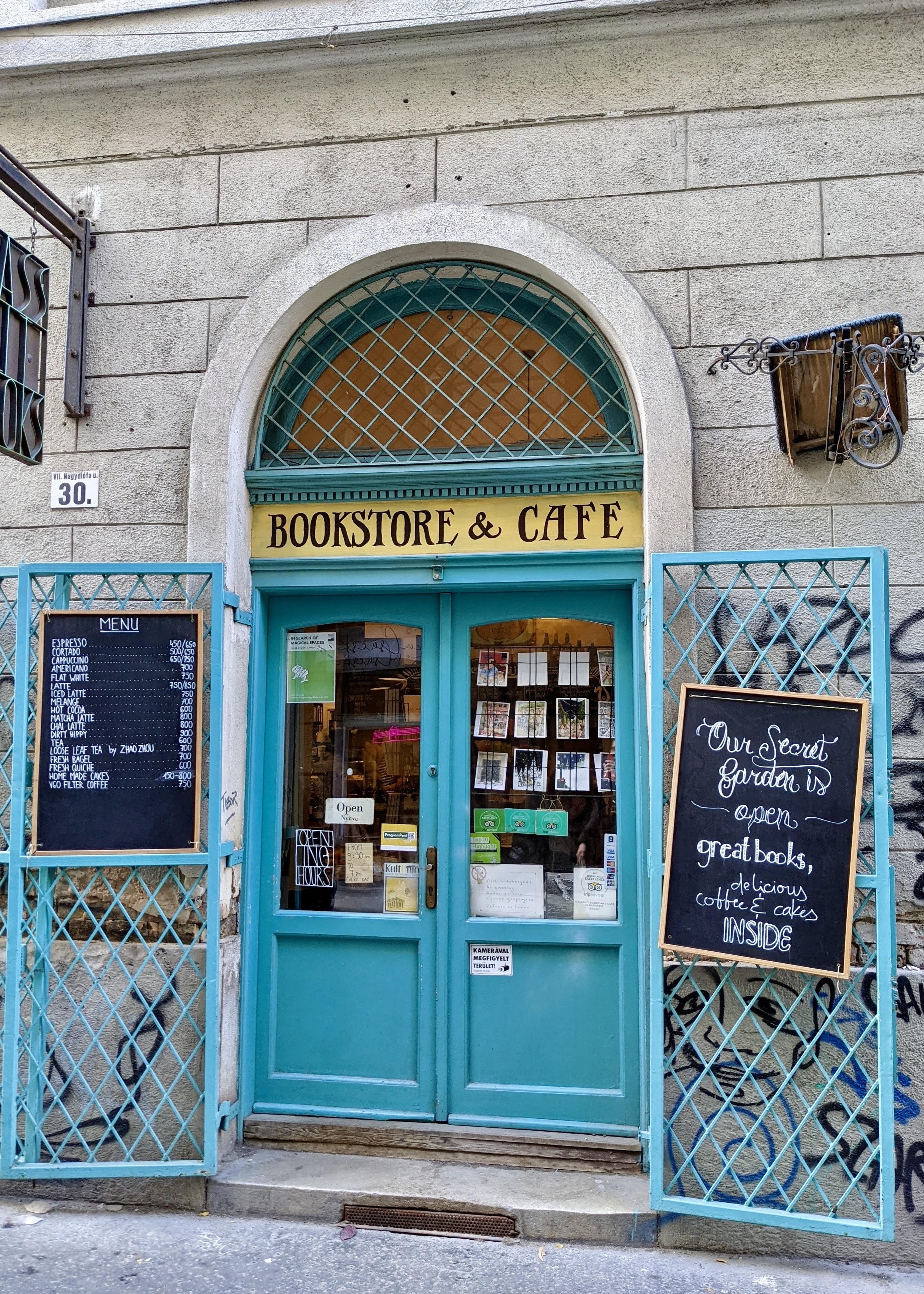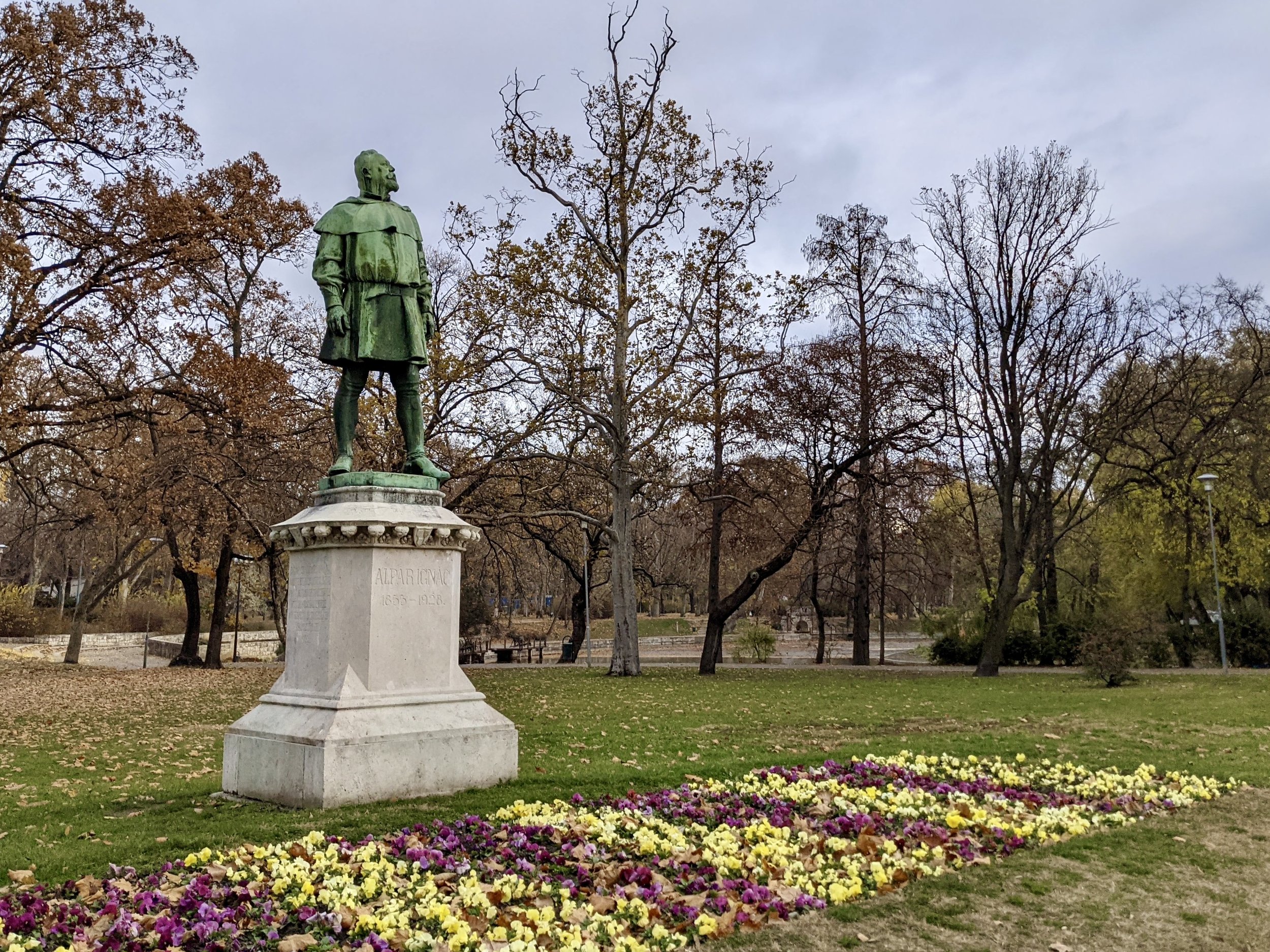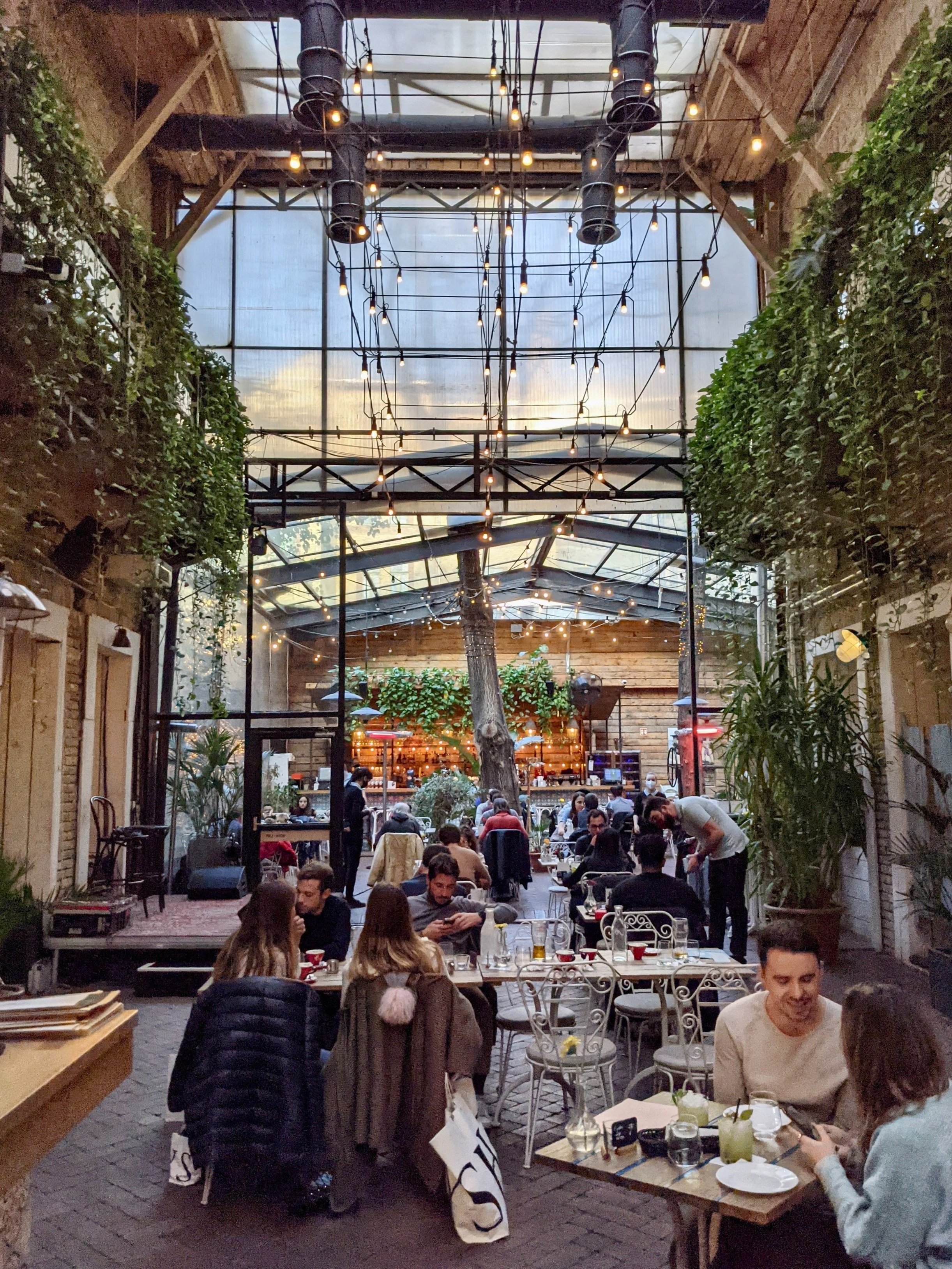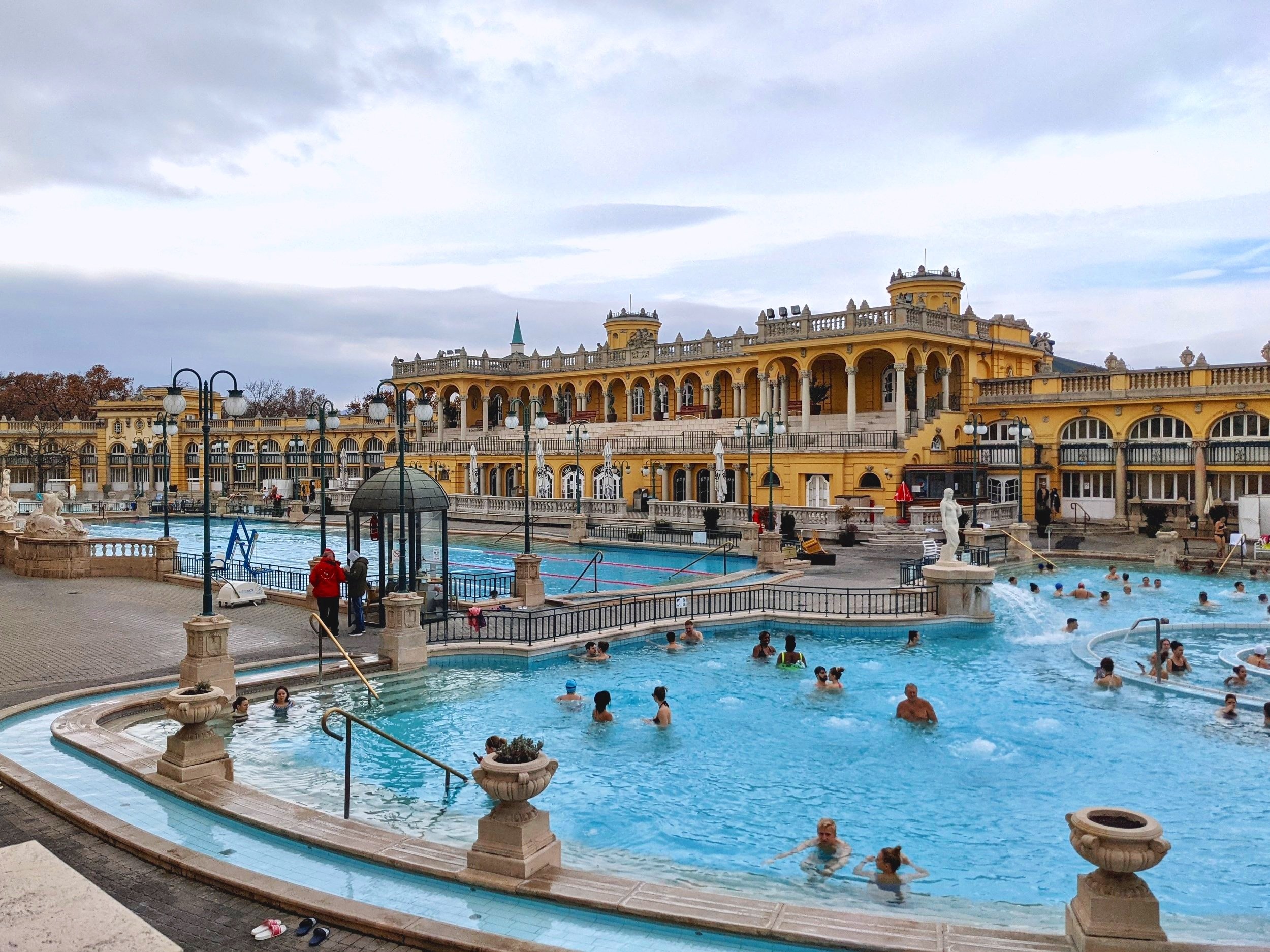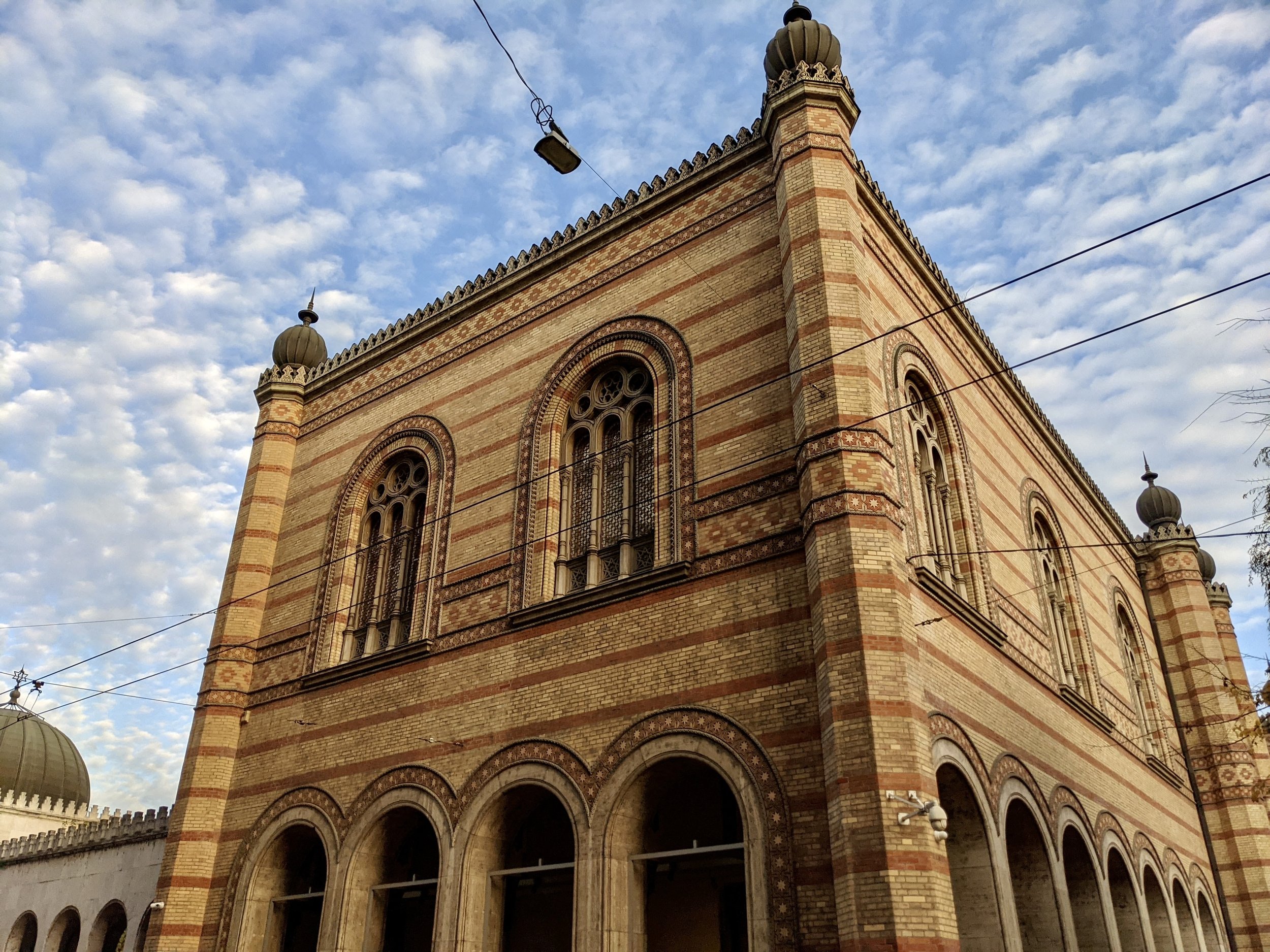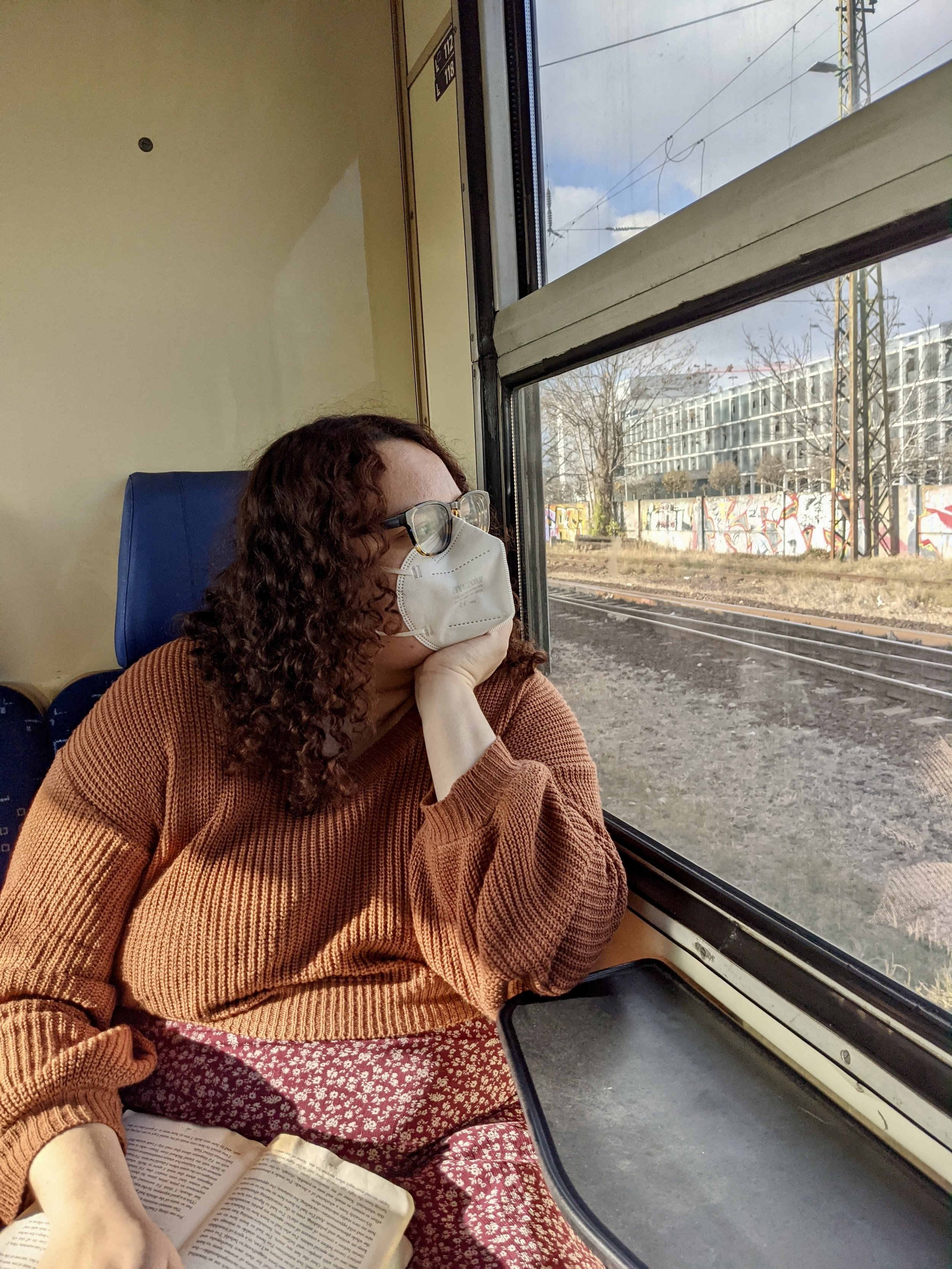13 Experiences Not to Skip in Budapest
Last updated: May 18, 2023
Budapest is a city you’ve just got to experience. It’s a well-known city and Hungary’s capital, so it’s definitely not underrated, however I don’t typically see it at the top of most people’s travel (or even European travel) lists.
I’m here to talk you into adding it to your list and/or give you a guide of some of the best things to do in Budapest! It might be my favorite city in Europe besides Berlin, and I am absolutely enchanted by the people, vibe, scenery, monuments, history, and food. This isn’t a complete travel guide to Budapest, but rather an experiences guide mixed with history and recommendations. Prices are included so that you can easily find experiences that best suit your interests and budget.
Find an accompanying map here.
Embrace Budapest’s coffee culture.
I love when modernity and tradition meet. Budapest’s coffee shop culture is a prime example of this, and the city is speckled with incredible third wave and old world coffee spots. Coffee culture thrived in Budapest in the early 1900’s, and at the time the city was home to around 500 cafés. These were popular with the general public, and a booming spot for the city’s writers and artists.
Many of these cafés faded away throughout the 20th century as a result of either being destroyed during the World Wars or shut down by communist leaders who were worried that cafés could be used for underground meetings for anti-communist organizations.
Today, the coffee culture spirit is once again thriving in Budapest, with a mix of revitalized historical cafés and avant-garde coffee houses finding their home in the city. With all the intermixed history, these cafés have become a classic Budapest experience, and you have to hit up a couple coffee shops when in town.
My recommendations:
Coffee Stand Dob: This utterly charming window café sells tasty coffee to go, along with a number of equally nice pastries. There are three in the city, but Dob is my favorite.
Masolit: Here you’ll find a pleasant coffee shop featuring used books for sale, a cozy interior, and a calming backyard.
Ruszwurm: Home to the oldest operating coffee house in Budapest, after first opening their doors in 1827. Be sure to indulge in a slice of one of their many decadent housemade cakes. More pricey than the previous two recs.
Price: Latte: 750 - 1350 HUF | 2 - 3.50 EUR
Masolit
Treat yourself to a wine tasting.
Luckily treating yourself in Budapest doesn’t typically break the bank. Hungary is a substantial wine producer with 22 wine regions adding up to over 150,000 acres of vineyards. Tokaj, a region northeast of Budapest is actually the world’s oldest classified wine region. Pretty cool, right? You can learn more about Hungary’s wine history here.
If you have the time for it and you’re interested definitely look into taking a trip to Tokaj or another wine region while you’re in the country. However, you don’t have to leave the city to taste quality local wine.
We ended up finding a place called Champion Wine Vinarium just steps from our hotel that offered a homely, yet inspiring wine tasting. We visited the wine shop around noon and scheduled a wine tasting for that evening.
When we arrived later that evening we ordered their cheese and meat board. Our host asked if we wanted to try three or five types of wine and we decided on five. With each pour she explained the history of the wine and which region of Hungary they came from, as well as interesting facts that I don’t think I would’ve otherwise learned about. She gave us plenty of time in between tastings to enjoy ourselves and we were the only people in the shop partaking in a tasting, so it felt like a private session. Everything was conducted in English as well.
The wine session was fairly peaceful until the very end when a local rock band took stage in the building’s basement and we could hear them jamming. We had dinner plans for after the tasting or else we probably would’ve joined in and tried to catch a song or two.
I don’t quite remember the cost, but I believe the cheese and meat board was around €8, and the wine tasting was around €10 or so per person. We ended up ordering another glass each at the end for a few more euros. Prices might have gone up a bit since then (from the reviews the price is relatively the same), but I wouldn’t mind paying more for the phenomenal service we got. Plus, the wines were delish! 10/10 experience easily.
If you’d like to book with them I suggest either giving them a call (+36 30 944 7779) or popping in the first day or two of your trip to reserve a tasting. We visited during off season, but I’m sure you could easily just walk in and have a tasting set up on the spot too.
Another wine shop I’ve heard good things about is Bortodoor City which offers wine tastings from €16 for up to six tastings, with a €5 surcharge for premium wines. You can book here or contact them directly.
P.S. We stayed at Medosz Hotel, which is conveniently located less than a five minute walk from both wine shops. They also offer free breakfast!
Price: Wine tasting (5-6 tastings): 4500 - 800 HUF | 12 - 21 EUR
Appreciate the city’s natural beauty.
You can enjoy vast natural beauty within and around the city. To name a few spots:
Margaret Island: Located in the center of the city and easy to get to via Margit or Árpád Bridge, Margaret Island or Margitsziget is a picturesque green oasis within the city, especially during summer.
Gellért Hill: A small, but pretty park offering shady trees. A short steep hike will reward you with a panoramic view of the city. At the base of the hill you’ll find the Gellért Hill Cave: a grotto chapel within a hillside cave. It looks quite small, but I so want to visit! It had just closed the last time I was in the area.
Buda Hills: Venture to the northwest outskirts of the city and you’ll find the Buda Hills. Here you can enjoy hiking trails, cycling trails, a children’s railway, and even a chairlift that you can ride and enjoy views of the city and nature for around €5 round trip. Get to this area with a direct 25 minute bus from the Budapest-Nyugati station.
Price: Hikes are free to access, additional excursions like visiting the Gellért Hill Cave or riding the children’s railway can range from 750 - 2000 HUF | 2 - 5 EUR.
City Park
Fall in love with Budapest’s food scene.
Heard of Lángos? What about Trdelník? Goulash, perhaps?
Hungarian food is rich, hearty, and soulful. If you haven’t tried it before, you’re sure to fall head over heels for it when visiting.
Here’s a few types of food you can keep an eye out for:
Lángos: Fried dough topped with sour cream, garlic, and shredded cheese. You can typically find other complimentary topping options offered including ham, various sauces, and vegetables.
Trdelník: Quite popular in Prague, but this dessert actually originates from Hungary. Dough is wrapped around a stick, fire cooked, then rolled in sugar, nuts, and cinnamon.
Gulyás / Goulash: Goulash is a thick stew made with meat, vegetables, paprika, and a variety of seasoning.
Csirke Paprikás / Chicken Paprikash: A fairly straightforward dish made with chicken, thick cream or sour cream, and paprika.
Halászlé / Fisherman’s Soup: A spiced paprika soup made with a few types of fresh fish. Paprika is pretty big in Hungary, as you’ve probably caught on.
Somlói Galuska: A trifle often dubbed ‘Hungary’s favorite dessert’ made of multiple types of sponge cakes, cream, raisins, walnuts, and chocolate.
And where to find them?
My favorite Hungarian dish is Lángos. I found my favorite Lángos at Lángosos, which is located in the Hunyadi Square Market. I didn’t get to visit, but I hear Retró Lángos is another good place to try this savoury fried dish. Kisharang Étkezde is awesome for trying a variety of Hungarian food in a homely setting with reasonable prices. For delectable Hungarian baked goods, particularly strudels, look no further than Strudel Húgo.
The Central Market Hall is the oldest and biggest market hall in Budapest and a popular spot in the city. You’ll find budget-friendly souvenirs like local paprika and honey, plus a mix of stands selling food, produce, and trinkets. Be aware though: not every food stall here is a hit, so watch out for tourist traps. Based off the reviews this is not the place to try Lángos, however other stalls here are pretty decent. I liked the caked we tried and the Hungarian food we enjoyed at the Panoráma Ételbár stand. I believe we tried the Chicken Paprikash and Goulash.
Let’s dive a little deeper. Budapest has its own unique foods stemming from its country’s traditions and history, but like most places it has a more diverse food scene to offer these days. Influenced by its neighboring countries, immigrants, and sub-cultures, you’ll find plenty of diverse and delicious food in Budapest.
Just by walking around the city you’ll be tempted by plenty of places, I know I was!
Jewish Food: The Jewish community has been present in Budapest since the 1200’s. The community dealt with a large deal of suffering for many hundreds of years, and the revival of Jewish life only started up again in the 1990’s after Hungary returned to democracy and the communist era came to a halt. Today you’ll find a mix of historically significant and up-and-coming kosher restaurants serving Jewish-Hungarian food. Rosenstein’s is one such place. Run by a Holocaust survivor who’s parents were murdered in Auschwitz, his story is a deeply intriguing one, and the recipes used are sacred: they’ve survived history and managed to be passed down for multiple generations. Another well-known spot in the city is Mazel Tov, where you’ll find yummy food in a beautiful bright environment. Make sure you try both the shawarma and pita. Find more Jewish restaurants in Budapest here.
Casual Eats: If you’re looking for some tasty food in a more lowkey setting I’d recommend trying Pizzica or Papitos. Pizzica sells pizza by the slice in a cool but casual industrial setting. Anyone who spends enough time in Europe can tell you that the Mexican food is seriously lacking, but Papitos delivers pretty well. Arán is an excellent choice for a casual breakfast of fresh baked items.
Vegan: With so many hearty eats in Budapest you might eventually find yourself craving something a little more green. The eateries Tahina and Rira have got you covered. Both offer hearty salads, bowls, soups, and wraps without sacrificing flavor. They’re both fast-casual so you can expect a fresh pick me up at a reasonable price. If you eat mostly plant-based the city has a lot of great vegan offerings.
Price:
Lángos with sour cream and cheese from Lángosos: 950 HUF | 2.50 EUR
Small plate of goulash with dumplings from Kisharang Étkezde: 1990 HUF | 5.20 EUR
Shawarma plate from Mazel Tov: 3500 HUF | 9.20 EUR
Slice of pizza from Pizzica: 300 - 500 HUF | 0.80 - 1.30 EUR
Take a dip in a thermal bath.
You’re in the City of Spas, after all.
Budapest’s bath culture stems from the city’s regional and social history. It’s been a part of Hungarian culture for hundreds over years, ever since Roman settlers first found the water to be relaxing and medicinal. With over 100 natural geothermal baths in the city, bathhouses became a place to cleanse oneself through washing, socializing, and eventually healing purposes.
Built in 1913, the Szechenyi Baths are the most visited attraction in Budapest. At over 100 years old, in a gorgeous setting, and the biggest baths in Budapest, they’re a great introduction to the city’s baths and spa culture in general.
However because they’re so popular it’s best to visit them anytime during off season (November to February) or first thing in the morning during peak and perhaps even shoulder season. I visited in the morning in late November and it was perfect, with very few people around until closer to noon. They’re clear about their sauna etiquette, and you’re recommended, but not required to remove all your clothing in saunas (like the spa houses I’m familiar with in Germany). At the Szechenyi baths most people just wear their swimsuits so if you’re not comfortable going full nude that’s totally okay. There’s around a dozen pools plus six sauna and steam rooms available, and I really liked my experience there.
At the Szechenyi Baths you can also book additional amenities like massages, mud treatments, and private rooms. Snacks and drinks are also available. If you have them on hand bring swimwear, a towel, and flip flops with you, otherwise you’ll have to rent or buy them for an additional cost. You can optionally bring other toiletries with you to use when you do your final rinse off at the end of your spa period. Your ticket will include a locker to store items.
Afterwards you can wander around the City Park that the bathhouse is located in. You’ll find a few monuments including the Vajdahunyad Castle, Heroes’ Square, Jaki Chapel, and interestingly enough a statue of the USA’s first president George Washington.
You can read this article to learn about more thermal bath options in the city. I think I’ll end up visiting the Gellért Baths or Veli Bej baths next to try somewhere new.
Price: Prices vary depending on bath house, and a day ticket to Szechenyi Bath House (which includes access to pools, saunas, steam rooms, and locker) ranges from 9400 - 10,900 HUF | 24.50 - 28.50 EUR.
Szechenyi Baths
Admire the country’s best art.
I’m a sucker for art museums, and I was elated when I heard about the Hungarian National Gallery’s permanent exhibition where you can find the country’s largest collection of Hungarian art. There’s something so deeply special about being in the same location as the origin of the art you’re viewing.
Just about everything I saw was unfamiliar to me, and before visiting it would’ve been virtually impossible for me to name a Hungarian artist or even recognize a painting by a Hungarian artist.
The museums features more than 10,000 Hungarian paintings from just the 19th and 20th century, in addition to Hungarian sculptures, illustrations, tombstones and contemporary art, plus some international exhibits as well.
If you visit keep an eye out of for pieces by the artist Károly Ferenczy. I spent a long time admiring his work, I so wanted to jump into a few of his paintings, they just looked so peaceful and serene. I was particularly fond of his works titled Morning Sunshine, Paintress, and Bathing Boys.
You can learn more here. Tickets are half off if you’re under the age of 27 and an EEA citizen.
Next time I think I’ll visit the Hungarian National Museum, which I’m especially drawn to because of their colorful and intricate painted ceilings.
Price: Nation Gallery Ticket: 3800 HUF | 10 EUR
Walk along the city’s bridges.
Together Buda and Pest make up Hungary’s capital, but they were once divided nations. Since the year 89, Buda, Pest, and Óbuda were separately ruled by a variety of nations including Celtics, Romans, Magyars tribes, Mongols, and Turks- just to name a few. It wasn’t until 1849, nearly 1800 years late when the first permanent bridge was constructed over this part of the Danube River, connecting Buda and Óbuda with Pest. By 1873 the three cities were unified as one and named Budapest.
Before the first permanent bridge, the Széchenyi Chain Bridge, was built the only way to cross was by boat in the warmer months and dangerously by foot across the frozen river in the colder months. During WWII Nazis blew up all the bridges in Budapest, and the suspended Chain Bridge was rebuilt and reopened in 1949, 100 years after it was first completed.
Needless to say, the bridges in Budapest hold a lot of historical significance for the city, and it’s considered a privilege to have these bridges available today. So be sure to walk across a bridge or two while you’re in town, you’ll find plenty of little intricate details on the bridges along the way. The Chain Bridge is a good one to cross for its history, architecture, and beauty, and I also like the Liberty or Szabadság Bridge for its proximity to the Central Market Hall and view of the Liberty Statue on Gellért Hill.
Price: Free
Szabadság or Liberty Bridge (with Liberty Square in the background)
See Budapest by water.
Sightsee along the Danube River with Buda on one side and Pest on the other. It’s a nice way to rest your feet while still getting to see some of the city’s grandest monuments. I ended up going with the Duna Bella cruise by Legenda and can recommend them! It wasn’t too fancy, but it was comfortable and quite pleasant. We sat at the lower level to stay indoors (it was quite chilly), but went up to the open air top deck for around five minutes towards the end of the tour to take in the unobstructed view.
We were given a welcome drink of hot apple tea (in the warmer months I believe this drink is lemonade), and also included was one additional drink (wine, beer, soda, or coffee) that you could go up and order at the mini bar when you were ready for it.
There were also headphones available to listen in to the historical narration. The story is split in half between two speakers called ‘Buda’ and ‘Pest’ who together weave a historical narrative of the city. This is available in over thirty languages. This particular tour was €13.50 and lasted around an hour and fifteen minutes.
Another tour that I heard about after my visit is the unlimited prosecco tour, which I’m sure had a more lively vibe than the tranquil tour I went on. The reviews are pretty solid and tickets are around €20, so I’m certainly tempted for next time!
Price: River Cruise Ticket: 5100 - 7600 HUF | 13.50 - 20 EUR
Visit Budapest’s most impressive monuments.
You’ll stumble upon quite a few inspiring monuments by simply navigating the city, but here’s a few you should intentionally find the time to visit, even if it’s just to see the exterior:
Castle District: Here you can find some of the top attractions in the city. You’ll find multiple museums, Buda Castle, the 13th century Matthias Church, and the 19th century Fisherman’s Bastion fortress. You can easily spend the better part of a day in this hilly area of Buda. Fisherman’s Bastion is probably the most famous attraction here, and the centuries old fortress features multiple lookout towers that grant impeccable views of the city. Because of all the history and architectural beauty, this area gets quite crowded as the day goes on so it couldn’t hurt to plan to visit earlier in the day.
Dohany Street Synagogue: Built in the 1800’s, this synagogue is the largest in Europe, and the second largest in the world, seating over 3,000 people. The design is Moorish, or a subset of Islamic design, and architects of the building aimed to create a unique architectural concept in order to help define synagogue style and Judaism in Europe.
Hungarian Parliament Building: An architecturally stunning building that you’re sure to get a nice view of if you take a boat ride along the Danube. With Gothic and Renaissance revival style, the attributes of the building are mesmerizing.
St. Stephen’s Basilica: Located in Pest, St. Stephen’s is the largest church in the city, and named after the first king of Hungary. Inside you can find the country’s most sacred religious relic: St. Stephen’s mummified right hand, called the Szent Jobb or the Holy Right Hand.
Vajdahunyad Castle: Previously mentioned, this castle and the neighboring Heroes’ Square are incredible spots and perfect to visit after a trip to the neighboring spa. You’ll find other interesting landmarks including a statue of the USA’s first president George Washington and the small but impressive 13th century gothic chapel, Jaki Chapel.
Price: The grounds of these locations are free for roaming, but entrance fees vary from 200 HUF | 0.50 EUR for the St. Stephen’s Basilica to 4500 HUF | 11.75 EUR for the Dohany Street Synagogue and Jewish Museum.
Dohany Street Synagogue
Jaki Chapel
View from Fisherman’s Bastion
Ride one of the oldest subway systems in the world.
Budapest is home to the third oldest metro system in the world, after London and Chicago. Line 1 was first operated in May of 1896, and in 2002 it was declared a UNESCO World Heritage Site. It’s also the world’s first electrified underground railway system and the oldest metro system in continental Europe. Line 1 is also called M1 or Millennium Line as construction was completed for the 1000th year of Hungary celebration.
It might not seem super interesting, and simply like a cost-efficient way to get from Point A to B, but this system inspired some of the world’s most used subway systems today. Some of the subway trains, like the yellow M1 line, are particularly charming as they operate nostalgic vintage style trains, while still maintaining pristine functionality.
If you’re geeking out and want to spend some time on this metro system, I found this proposed ‘Metro Crawl’ to be interesting.
Price:
Single Ticket: 350 HUF | 0.92 EUR
90 Minute Ticket: 750 HUF | 2 EUR
72 Hour Ticket: 5500 HUF | 14.50 EUR
I could not find a photo of Budapest’s metro (although I know I’ve taken some!!!), but here I am on a train from the airport headed to the city center.
Take in the city’s ruins.
Heard of ruin bars? Ruin bars are a symbol of both Budapest’s modern day culture and its dark history. During Nazi occupation, many Jews fled the city or were taken by German troops to concentration camps. This led to abandoned buildings in the Jewish Quarter. Years later there was a resurgence of life in these buildings as they became popular drinking spots. Eventually an assortment of furniture was brought into the buildings, creating a whimsical and diverse interior and a place to drink for cheap.
Since then, ruin bars have evolved into an iconic characteristic of Budapest. Although they’re no longer an underground spot, they still cannot be skipped. Szimpla Kert is Budapest’s most popular ruin bar and is also the first ruin bar in the city. On most nights the bar is packed and there’s a line out the door of people waiting to get in. While you’re here you can grab a bite to eat at the neighboring outdoor street food market and wait for the line to go down, or just opt to visit earlier in the evening. The bar opens around 3PM during the week, noon on Saturdays, and 9AM on Sundays.
The nighttime vibe is cool, but I much prefer visiting during the daytime before the nightly rush and opt for a coffee rather than a beer. During the day when it’s not packed with people you can truly see how vast the building is, as well as marvel at all the intricate eclectic details that have accumulated in the ruins over the years. If you’re around on a Sunday morning you can visit their weekly market and grab a baked good or locally made trinket at one of the stalls. Find out about more ruin bars here.
Price: Free to enter. 200mL of red wine is 1600 HUF | 4.20 EUR.
Discover the city’s nightlife.
Past the city’s ruins, there’s plenty of more fun nightlife in the city. A moonlight stroll or evening river cruise will set you up for a charming evening, but if you’re in the mood for a bar or two, here are a few you can check out:
Rumpus Tiki Bar: For cool bartenders and even cooler drinks look no further than Rumpus Tiki Bar. The staff is so friendly, and the drinks are great. The menu details the flavor profile and alcohol content of each drink so it’s easy to find something you like. Spots fill up pretty quick on weekend evenings so you can make a reservation if you’re a bigger group. We sat at the bar and had a lot of fun chatting with the staff and watching all the drinks be made.
Béla Bár: For a more local night out stick to the Buda side of the city. Béla Bár is a lovely choice! With creative and artsy decor, a welcoming and homey vibe, and well-made drinks, you’ll be sure to have a good evening here. Keep in mind that they’re only open until 11PM.
360 Bar: Like the name suggests, this is a good bar for enjoying a drink while getting a 360 view of the city. They have a few solid cocktails too! I wouldn’t come here for more than a round or two because there are more cost-friendly and interesting spots in the city.
Price: Most drinks are between 1500 - 4500 HUF | 3.90 - 11.75 EUR.
Take advantage of seasonal activities.
Some of the best things to do in any city are seasonal events!
A few ideas:
Eat your way through a Christmas market or two if you visit the city in wintertime. I visited in mid-November and the markets had just opened!
If you visit in the springtime take a stroll and seek out Budapest’s blossoms.
In the summertime, cool off with a day trip or overnighter to Lake Balaton, Central Europe’s largest lake. It’s home to beautiful landscapes, your pick of wineries, and historic small towns.
Take a hike up Gellért Hill or through one of the city’s parks to find Budapest’s most picturesque autumn colors and fall foliage.
Plus, events are constantly happening in Budapest! From festivals to weekly markets, there are many personal and unique ways to take in this city.
Price: Varies, but can usually be enjoyed free or low cost.
Christmas Market at St. Stephen’s Basilica
Budapest, etc.
Happy travels! Find a map of all mentioned spots here.
View from 360 Bar
Where to next?
Extend your Europe trip:



